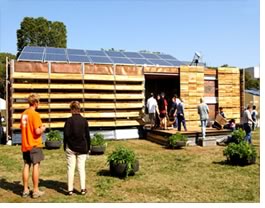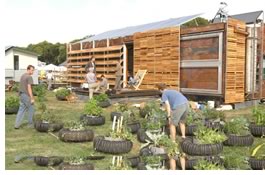
 Sometimes
it pays to have a Cavalier attitude. During the Solar Decathlon on the
Capital Mall, the architecture and engineering team from the University
of Virginia captured the imaginations of an all-star architecture jury
September 29, winning first place in the Design and Livability contest,
one of the 10 categories that comprise the decathlon. Design and Livability
carries the greatest weight in the decathlon's overall point score: a
maximum of 200 points; the other nine contests count a maximum of 100
points each.
Sometimes
it pays to have a Cavalier attitude. During the Solar Decathlon on the
Capital Mall, the architecture and engineering team from the University
of Virginia captured the imaginations of an all-star architecture jury
September 29, winning first place in the Design and Livability contest,
one of the 10 categories that comprise the decathlon. Design and Livability
carries the greatest weight in the decathlon's overall point score: a
maximum of 200 points; the other nine contests count a maximum of 100
points each.
The entry, officially themed "It's Not Your Father's House," presents a dwelling unit that the UVa Team claims might not be recognizable by previous generations. Perhaps offering the widest range of high tech and high touch among the 14 entries, the house balances a "smart wall" energy controller with reclaimed and sustainable materials used throughout.
 The
smart wall, the brain center of the house, manifests itself as an LED-wall
in the entrance hall. Through a touch-screen TV, it runs the controls
throughout the house. Energy systems include radiant floor heating, valance
cooling (a pipe along the top of the south wall with cooling fluid running
through it), and of course, PV arrays on the roof. The load is tempered
by recycled shipping pallets fashioned into louvers controlled by the
smart wall: in the down position, the louvers stop direct solar gains;
in the up position, they act like a light scoop to send light to the interior.
The
smart wall, the brain center of the house, manifests itself as an LED-wall
in the entrance hall. Through a touch-screen TV, it runs the controls
throughout the house. Energy systems include radiant floor heating, valance
cooling (a pipe along the top of the south wall with cooling fluid running
through it), and of course, PV arrays on the roof. The load is tempered
by recycled shipping pallets fashioned into louvers controlled by the
smart wall: in the down position, the louvers stop direct solar gains;
in the up position, they act like a light scoop to send light to the interior.
High-touch is reinforced by using copper cladding reclaimed from an old roof over wood framing of birch and bamboo, two of the fastest-growing trees. The team also designed some of the recycled shipping pallets into a rain screen to shade and protect the copper. Another high-touch amenity is the house's green roof, which offers a private patio space as well as another link to nature. And, no doubt unique to the UVa's design: reclaimed paving stones from the terrace of Mr. Jefferson's rotunda at the university grace the passive sun space/entryway.
"The University of Virginia should be justly proud of their win in this first contest," said Assistant Secretary of Energy for Energy Efficiency and Renewable Energy David Garman. "They were judged the best in this category by a panel of some of our nation's best architects."
 All-star
panel of judges
All-star
panel of judges
The decathlon judges included:
• Jury Chair Stephanie Vierra, consultant, design and education services
• Glenn Murcutt, William Henry Bishop Professor at Yale University
and this year's Pritzker Prize winner
• Edward Mazria, AIA, Mazria, Riskin and Odoms Inc.
• Steven Paul Badanes, Howard Wright Endowed Chair, University of
Washington
• Ed Jackson Jr., PhD, director of Applied Research, AIA
• J. Douglas Balcomb, PhD, research fellow, National Renewable Energy
Laboratory.
"In addition to its technical and experiential qualities, there is an element of delight in the UVa house that I would describe as déjà vu," Jackson said. "You instantly know it works because even though it's new, it feels comfortable and familiar. The balance of mass and openness, light and shadow, texture and pattern creates a rhythm. The sense of delight gels as soon as you walk in and see that the technology does not get in the way of the communication between inside and out."
"The Solar Decathlon will inspire these students to continue to search for new ways to design and build homes," Garman added. "They are proving that we can have homes that are attractive and comfortable and still use energy wisely."
For the competition, the decathletes had to design a house that captures enough solar power to supply all energy needs for heating, cooling, hot water, lighting, appliances, computers, and charging an electric car. Experts from the U.S. Department of Energy (DOE) and its National Renewable Energy Laboratory organized the event. In addition to DOE and NREL, sponsors of the Solar Decathlon are the AIA, BP Solar, The Home Depot, and EDS.
The University of Puerto Rico-Mayaguez placed second and the University of Texas at Austin third in the Design and Livability event. To view the scores of the competition to date, visit the Solar Decathlon site.
Copyright 2002 The American Institute of Architects. All rights reserved.
![]()
|
If you visit their Web site, (and you must visit their Web site!) you will see in detail how the house works and learn that the University of Virginia team has nicknamed its project the "Trojan Goat." The UVa Project Management Team is: For more on the Solar Decathlon, visit the event Web site. |
|